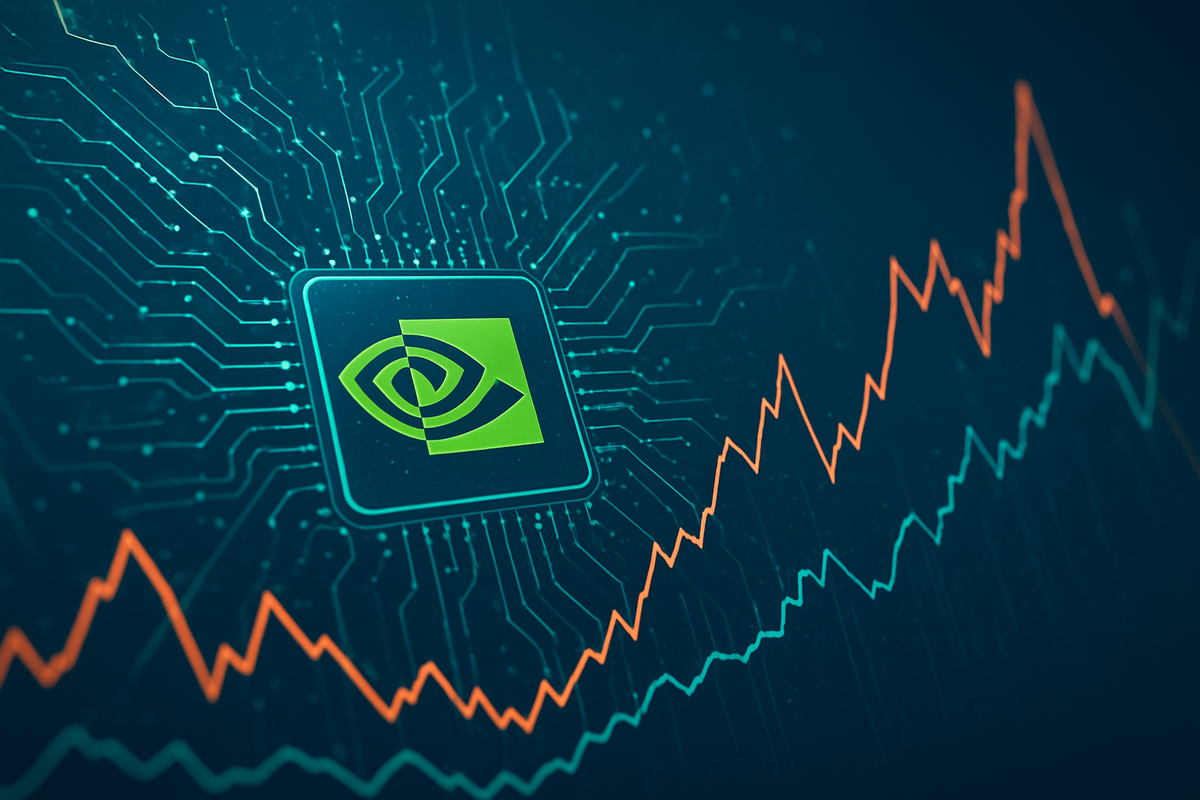Nvidia's Rollercoaster Ride: AI Kingpin's Volatility Fuels "Bubble" Fears Amidst Record Earnings
By:
MarketMinute
November 21, 2025 at 12:43 PM EST

Nvidia (NASDAQ: NVDA), the undisputed titan of artificial intelligence chip manufacturing, has been at the epicenter of significant market movements and intense speculation following its recent stellar earnings report. Despite shattering analyst expectations with record revenues and an optimistic outlook, the company's stock has experienced notable swings, igniting fervent discussions across financial markets about the potential formation of an "AI bubble." This volatility, coupled with the extraordinary valuations seen across the AI sector, is not only influencing the performance of major technology firms but also contributing to a palpable sense of apprehension throughout the broader stock market. As Nvidia's market capitalization briefly touched an unprecedented $5 trillion, its every movement is scrutinized as a barometer for the entire AI-driven rally, prompting investors to weigh genuine technological transformation against the specter of speculative excess. Nvidia's AI Dominance Meets Market SkepticismNvidia's financial performance has been nothing short of spectacular, yet it has paradoxically amplified concerns about market sustainability. The company's third-quarter fiscal year 2026 earnings report, released on November 19, 2025, showcased a dominant position in the burgeoning AI landscape. Nvidia reported a record revenue of $57.0 billion, marking a substantial 22% sequential increase and an astounding 62% year-over-year jump, comfortably surpassing Wall Street's forecasts. Adjusted earnings per share (EPS) also exceeded expectations at $1.30. The primary engine behind this explosive growth was Nvidia's Data Center segment, which alone generated a record $51.2 billion in revenue, a 25% increase quarter-over-quarter and a 66% surge year-over-year. This segment now accounts for the vast majority of the company's total sales, underscoring the insatiable demand for its specialized AI chips that power large language models and other advanced AI applications. CEO Jensen Huang's declaration that "Blackwell sales are off the charts, and cloud GPUs are sold out" highlighted the immense, ongoing demand for their proprietary superchips. The company also provided an optimistic revenue forecast of $65.0 billion (plus or minus 2%) for the fourth quarter of fiscal year 2026, further cementing its leadership. Despite these glowing figures, Nvidia's stock has demonstrated considerable volatility. For instance, on November 21, 2025, the stock decreased by 3.05%, following a 3.15% drop on November 20, 2025. This post-earnings dip, despite the positive report, underscores a market grappling with an "increasingly fragile tone" and deep-seated concerns about an AI bubble. The company's significant weighting in indices like the S&P 500 means that its sharp movements can single-handedly sway the direction of the broader market, making its earnings calls critical tests for the entire AI-fueled rally. This delicate balance between robust corporate performance and broader market jitters defines the current investment landscape for Nvidia and the AI sector. The Winners and Losers in the AI Gold RushThe significant swings in Nvidia's (NASDAQ: NVDA) stock and the broader "AI bubble" discourse are creating a discernible divide among public companies, distinguishing those poised to win from those facing potential headwinds. At the forefront of the beneficiaries are companies deeply integrated into the AI infrastructure ecosystem, particularly the "hyper-scalers" and cloud computing giants. Potential Winners:
Potential Losers/At Risk:
The market's current climate suggests a flight to quality within the AI space. Companies with strong balance sheets, diversified revenue streams, and clear pathways to monetizing AI are likely to weather potential turbulence better than those built on speculative hype alone. The Broader Implications of the AI Gold RushNvidia's (NASDAQ: NVDA) stock volatility and the "AI bubble" discussions are not isolated events; they are symptoms of a profound technological shift with far-reaching implications for the global economy and financial markets. This situation fits into a broader industry trend of rapid technological adoption, reminiscent of past industrial revolutions, but with an unprecedented pace driven by digital connectivity and computational power. Broader Industry Trends and Ripple Effects:
Regulatory and Policy Implications:
Historical Precedents: Comparisons to the dot-com bubble of the late 1990s are inevitable. During that era, companies with "dot-com" in their name saw their valuations skyrocket based on speculative promise rather than proven profitability. While the current AI boom shares some characteristics – rapid valuation surges, intense investor enthusiasm, and a focus on transformative technology – there are key differences. Unlike many dot-com companies, Nvidia and other leading AI firms possess strong fundamentals, significant revenues, and clear business models. However, the risk lies in the broader market's willingness to overpay for future potential, which can lead to corrections when expectations outpace reality. The "Nifty Fifty" era of the 1960s and early 70s, where a group of blue-chip stocks traded at elevated multiples, also serves as a cautionary tale about market concentration and overvaluation, even for fundamentally strong companies. Navigating the Future of AI InvestmentThe current landscape, marked by Nvidia's (NASDAQ: NVDA) volatility and the "AI bubble" debate, points to a dynamic and potentially transformative period ahead for financial markets and the technology sector. Understanding what comes next requires considering both short-term market reactions and long-term strategic shifts. Short-Term and Long-Term Possibilities: In the short term, we can expect continued market volatility, particularly around key earnings reports from major AI players and macroeconomic data releases. Investor sentiment will remain highly sensitive to any news that either confirms the AI growth narrative or suggests overextension. There might be periodic profit-taking corrections as some investors lock in gains, especially if the broader market shows signs of weakness. For Nvidia specifically, while demand remains robust, any signs of cooling in hyperscaler spending or increased competition could trigger immediate stock reactions. In the long term, the fundamental drivers of AI adoption—such as increased automation, data analysis capabilities, and the creation of new products and services—are likely to persist. This suggests that the underlying growth trajectory for AI technology and its foundational companies remains strong. However, the market will likely mature, differentiating between companies with sustainable business models and those built on speculative hype. We could see a consolidation in the AI sector, with larger, well-capitalized companies acquiring innovative startups. Potential Strategic Pivots or Adaptations Required:
Market Opportunities and Challenges: Opportunities:
Challenges:
Potential Scenarios and Outcomes:
Ultimately, the future will likely involve a blend of these scenarios, with the enduring power of AI technology continuing to drive innovation, but within a more scrutinized and potentially volatile market environment. Concluding Thoughts on the AI RevolutionNvidia's (NASDAQ: NVDA) recent stock performance and the surrounding "AI bubble" discourse encapsulate the exhilarating yet precarious nature of the current technological revolution. The company's record-breaking earnings underscore the profound and accelerating demand for artificial intelligence infrastructure, confirming that AI is not merely a fleeting trend but a fundamental shift reshaping industries globally. However, the market's nervous reaction to these stellar results, manifested in significant stock volatility, highlights a growing apprehension that valuations in the AI sector may be outpacing tangible, immediate returns, drawing parallels to historical speculative manias. Moving forward, the market will likely demand greater scrutiny and discernment from investors. The era of broad, indiscriminate investment in anything labeled "AI" may be drawing to a close. Instead, a focus on companies with clear business models, sustainable profitability, and a demonstrable competitive advantage within the AI ecosystem will become paramount. This includes not only the chipmakers like Nvidia but also the cloud providers, specialized AI software developers, and enterprises effectively integrating AI to drive efficiency and innovation. Investors should closely monitor several key indicators in the coming months. These include the spending patterns of major hyperscalers on AI infrastructure, which directly impacts Nvidia's core business; the emergence of new regulatory frameworks for AI, which could shape industry practices; and the actual return on investment from corporate AI initiatives, which will validate or challenge current valuations. Furthermore, any significant shifts in the competitive landscape, such as new entrants or technological breakthroughs from rivals, will be critical to watch. While the potential for AI to transform the global economy remains immense, the path ahead will likely be characterized by both continued innovation and heightened market scrutiny, requiring a balanced perspective from all stakeholders. This content is intended for informational purposes only and is not financial advice More NewsView More
History Says These are 3 Stocks to Buy for December ↗
Today 7:13 EST
Via MarketBeat

Warner Bros. Sale Rumors Heat Up: What Investors Need to Know ↗
November 25, 2025
Via MarketBeat

From Science Project to Solvent: WeRide’s 761% Revenue Surge ↗
November 25, 2025
Via MarketBeat


Via MarketBeat
Recent QuotesView More
Stock Quote API & Stock News API supplied by www.cloudquote.io
Quotes delayed at least 20 minutes. By accessing this page, you agree to the Privacy Policy and Terms Of Service.
© 2025 FinancialContent. All rights reserved.
|